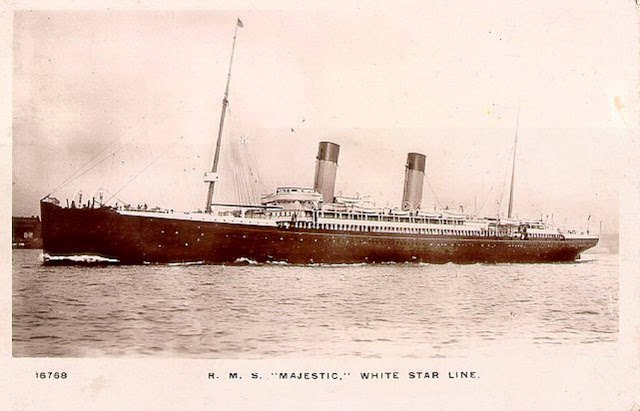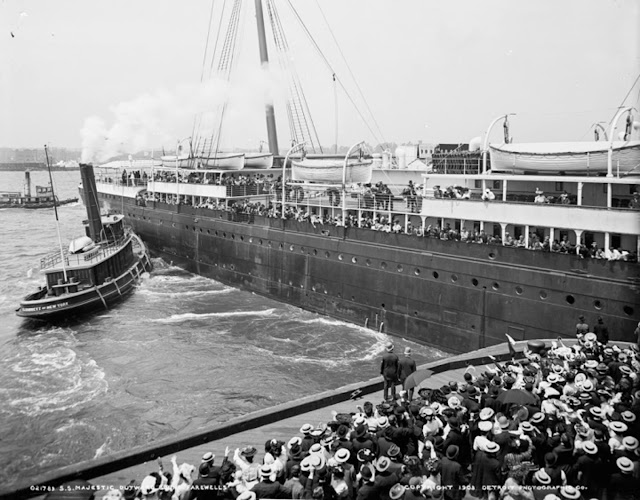TITANIC and MAJESTIC (1890), both Royal Mail Ships, hand in hand? How so?
The review of João Martins will show.
by João Martins, editing by Earl of Cruise
The review of João Martins will show.
by João Martins, editing by Earl of Cruise
And WHITE STAR LINE was more than only a shipping line which employed rms TITANIC. WHITE STAR was company with a great heritage and introduced many innovations which became standards. Founded by Thomas Henry Ismay, originally from Maryport, and shareholders amoung whom had been HARLAND&WOLFF. Later the Irish shipbuilder, located in Belfast, built all ships for WHITE STAR.
rms MAJESTIC as built by HARLAND&WOLFF - Source: Wikipedia (original seize)
The rms MAJESTIC was a 9,965 GRT
British ocean liner built by HARLAND & WOLFF for WHITE STAR LINE and
completed in 1890. Her career was profoundly intertwined with rms TITANIC.
In the late 1880s competition for
the Blue Riband, the award for the fastest Atlantic crossing, was fierce
amongst the major shipping lines. At the time the prize belonged to CUNARD's
rms ETRURIA and in 1889 it was snatched by the INMAN LINE's ss CITY OF PARIS, 1888, the second to bear this name.
ss CITY OF PARIS, INMA LINE - Source: Wikipedia (original seize)
WHITE STAR LINE decided to order two
new ships from HARLAND & WOLFF that would have an average crossing speed of
20 knots.
The rms MAJESTIC was the second of
this duo, the first being rms TEUTONIC. Just like her sister, she was 178
metres long and had two triple expansion steam engines powering two propellers.
However, she was slightly smaller in tonnage and had a top speed of 20 knots,
0.5 knots below her older sibling.
She could carry 300 first class, 190
second class and 1000 third class passengers.
rms MAJESTIC in the early years - collection João Martins
Also just like rms TEUTONIC, the
vessel was built under the Armed Auxiliary Cruiser Agreement, a deal the
company had struck with the British government in which the new ships would be
available as armed merchant cruisers in time of war in return for partly
funding of the construction.
On 2 April 1890, the rms MAJESTIC
left on her maiden voyage from Liverpool to New York City. She completed the
trip in 6 days and 10 hours, which was not enough to capture the Blue Riband.
In September of that year, while
docked in New York, a fire broke out on board while cotton bales were being
loaded into her cargo holds. Crew members, a fireboat and firefighters managed
to quickly extinguish the fire and there was no serious damage.
On a westbound voyage between 30
July and 5 August 1891, the rms MAJESTIC managed to take away the Blue Riband
from the ss CITY OF PARIS with an average speed of 20.1 knots. Unfortunately,
she held the honour for a mere two weeks, when her own sister snatched it from
her.
At 3.30 AM on 30 July 1894, in dense
fog, she collided and cut through ANTELOPE, a Newfoundland fishing schooner,
killing 2 of that ship's crew members.
In 1895 the rms MAJESTIC was
assigned a new captain named Edward J. Smith, later notable as the captain of the
rms TITANIC. Smith served as her captain for nine years. On 1 May 1898 she
collided with her quay in New York and sustained broken plates that started to
leak. The damage was not serious.
In December 1899 she was called in
to serve as a troopship in the Boer War. She made her first trooping voyage
between Liverpool and Cape Town the same month, and the second and last one in
February 1900, always under the command of Edward John Smith.
rms MAJESTIC in a periodic postcard - editors collection
In 1902–1903, the ship underwent a
refit, which included new boilers (and consequently taller twin funnels) and
the removal of one of her 3 masts, after which she returned to the
Liverpool-New York run. Smith left as captain in 1904 to take on the new rms Baltic,
then the largest ship in the world.
In 1905, the rms MAJESTIC suffered a
fire in her bunker with no significant damage. In 1907, WHITE STAR's
main terminal was moved from Liverpool to Southampton and on 26 June she sailed
from these new facilities for the first time.
On 5 April 1908, while under the
command of Captain Bertram Hayes, she rescued the crew of HELIOS, a stranded
Norwegian tanker in the North Atlantic.
Her sister ship rms TEUTONIC was
removed from the New York run with the arrival of rms OLYMPIC in 1911 and
reassigned to the Canadian service.
The same way, when the largest ship
in the world, the breathtaking 46,000 GRT rms TITANIC was handed over to WHITE STAR in 1912, rms MAJESTIC was retired from service and designated as a reserve
ship, biding her time at Birkenhead's Bidston Dock.
By April 1912, she had been moved to
the innermost corner of the Ocean Dock in Southampton. From there she had a
splendid view of rms TITANIC's departure on her maiden voyage on April 10.
When rms TITANIC sank in the North
Atlantic 5 days later, the rms MAJESTIC was quickly pressed back into service
to fill the gap in the transatlantic schedule.
rms MAJESTIC in a periodic postcard - collection João Martins
In May 1913 one of her crewmen,
Edward Turner, was presumed to have committed suicide by jumping overboard.
About 3 days later another crew member, William Keoun, tried to commit suicide
by jumping overboard but was heard and seemed to change his mind once he hit
the water. The ship's port side emergency boat was lowered and her First
Officer David Blair (who was TITANIC's original Second Officer) jumped into the
sea to save the man, both being safely brought back aboard.
rms MAJESTIC in a 1903 photography by DETROIT PHOTOGRAPHIC Co. (top and below)
On 17 October 1913, she came to the
rescue of the French schooner GARONNE, which had wrecked.
On 14 January 1914 the rms MAJESTIC
left Southampton on her last voyage. As she was leaving Cherbourg during the
Channel stopover, a tender struck her and a coaling port was damaged, which was
repaired before she continued.
When she arrived in New York a
tugboat sank with fire pouring out of her engine room after rms MAJESTIC's
stern had struck her while she was docking. There were no injuries.
Soon after, she was sold for £26,700
for scrap to the THOS W WARD yard at Morecambe. Before scrapping the ship, the
company opened her for public tours and some of the still-beautiful interior
panelling was saved and used in the offices of the Ward company.








Comments
Post a Comment